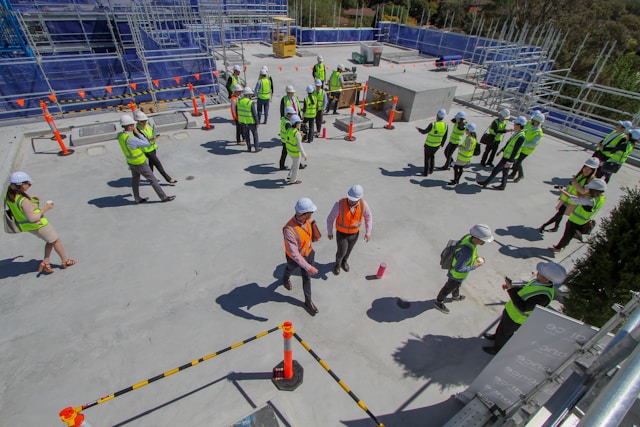In today’s competitive landscape, tender submissions require a strategic approach. One way to go above and beyond and distinguish yourself is by demonstrating a commitment to gender equality procurement.
It’s about fostering an inclusive environment throughout your company, your supply chain and ensuring equal opportunities for diverse talent.
Expanding the scope of equality in procurement
The push for gender equality in procurement isn’t a passing fad. It’s here to stay.
Federal, State and local governments across Australia are actively implementing policies that encourage companies to not only promote gender balance, but also improve employment outcomes for a wider range of disadvantaged cohorts in the workforce.
This includes groups like the long-term unemployed, youth facing challenges entering the workforce, single mothers, and individuals with lower-than-average literacy, language, and numeracy (LLN) skills.
This broader approach to equality presents both opportunities and challenges for Australian businesses.
What are the challenges of gender equality procurement for Governments?
One major concern for governments is ensuring transparency.
Companies might be tempted to engage in “equality-washing,” similar to the phenomenon of “green-washing” with environmental targets.
This involves presenting inflated or misleading data to create the illusion of strong diversity and inclusion practices. To prevent this, governments will need to develop robust auditing processes to verify the data submitted by tenderers.
What are the challenges of gender equality procurement for tenderers?
For your company vying for government contracts, this broader focus on inclusivity necessitates adjustments to your procurement practices.
This could include:
- Expanding your sourcing: Your procurement teams, responsible for goods and services (Group Procurement), will need to explore new avenues to source talent and resources from diverse vendors and suppliers.
- Alignment across departments: Streamlining your processes is crucial. Human Resources, tasked with talent acquisition, and procurement teams need to collaborate and implement consistent diversity and inclusion targets, reporting methods, and management frameworks.
- Effective governance: Implementing these changes won’t be cost-free. Your company may need to invest in effective management and governance structures to ensure you meet your expanded equality targets.
Ultimately, these costs might be passed on to governments through higher project bids.
Despite the challenges, promoting broader equality in procurement creates a more equitable and diverse workforce. This can lead to a more innovative and productive business landscape, ultimately benefitting both companies and the Australian economy as a whole.
Why should you integrate gender equality procurement practices?
Integrating gender equality procurement practices into your tenders offers several advantages:
- Meet evolving requirements – Many government and public tendering authorities actively promote or even mandate consideration of gender equality in their projects. A well-defined plan demonstrates your alignment with these requirements and values.
- Enhanced brand reputation – Consumers are increasingly conscious of company social responsibility. Highlighting your commitment to gender equality procurement showcases your dedication to diversity and inclusion, positively impacting your brand image.
- Improving potential – A diverse workforce fosters a more innovative and creative environment. By ensuring equal opportunities across genders, you tap into a wider pool of talent and expertise, leading to potentially better solutions.
How do you demonstrate gender equality procurement in a tender?
Promoting gender equality procurement involves a broad approach.
Here are some key strategies you can incorporate into your tender submissions:
Diversity and inclusion goals
- Outline specific targets – Beyond just stating a commitment to gender equality, set concrete goals. This could involve aiming for a specific percentage of your workforce on the project to come from underrepresented genders, or targeting a spend allocated to suppliers with strong diversity and inclusion practices.

- Transparency and reporting – Demonstrate your commitment to transparency by outlining how you track progress towards your gender equality goals. Mention any reporting mechanisms in place to monitor and improve your approach.
Example: A construction company outlines a goal for at least 30% of its project workforce to be comprised of women or individuals from underrepresented genders.
They mention their use of diversity recruitment tools and partnerships with training programs aimed at fostering female participation in the construction industry.
Inclusive work practices & culture
- Highlight equal opportunity policies – Mention any policies you have in place to ensure equal pay, promotion opportunities, and career advancement for all genders within your company and amongst your suppliers.
- Flexible work arrangements – Demonstrate your commitment to work-life balance by mentioning any flexible work arrangements you offer, such as remote work options or flexible working hours. This can be particularly attractive to talent with childcare or other responsibilities.
Example: A software development company emphasises its commitment to gender equality within its own team.
They highlight their company-wide policy of equal pay for equal work and their flexible work program that allows employees to maintain a healthy work-life balance.
Gender-Neutral tender evaluation criteria
- Focus on skills and experience – Ensure your evaluation criteria prioritise the specific skills, experience, and qualifications required for the project. Avoid any language or criteria that could be perceived as biased towards a particular gender.
- Blind evaluation processes – Consider implementing a blind evaluation process for certain aspects of your tender selection. This removes any unconscious bias that might exist during the evaluation stage.
Example: A marketing company revises their evaluation criteria for a social media campaign.
While they mention the need for strong analytical and content creation skills, they remove any preference for specific team structures or leadership demographics.
Supplier Onboarding and Support
- Diversity & inclusion training for suppliers – Offer diversity and inclusion training programs for your suppliers. This can help them cultivate a more inclusive work environment within their own organisations.
- Mentorship opportunities – Consider implementing mentorship programs where experienced professionals from your company can guide and support aspiring talent from underrepresented genders within your supply chain.
Example: A manufacturing company partners with a business association dedicated to promoting gender equality.
They offer joint training programs for their suppliers and their employees on topics like unconscious bias and inclusive workplace practices.
Promoting gender equality is not just about meeting tendering requirements. It’s about fostering a more diverse and inclusive business landscape. By integrating these strategies into your tender submissions, you demonstrate your commitment to a positive social impact, attract top talent across genders, and potentially find innovative solutions for your project.
In doing so, you create a win-win situation for your company and for a more equitable future.
Win more tenders
With gender equality procurement – we’ll show you how!
FAQS for gender equality procurement
What is gender equality procurement practices?
Gender equality procurement practices involve selecting goods, services, and works that consider the impact on gender equality and actively seek to empower women and disadvantaged groups in the workforce. This goes beyond just women-owned businesses and focuses on creating a more inclusive supply chain.
How do companies promote gender equality?
Companies can promote gender equality by implementing initiatives like equal pay for equal work, flexible work arrangements to support work-life balance, and unconscious bias training to create a more inclusive work environment where all genders have equal opportunities for advancement.
How do you ensure gender equality in a project?
Ensuring gender equality in a project requires a two-pronged approach. Firstly, implement inclusive recruitment practices to attract and retain talent from diverse genders. Secondly, integrate gender-neutral evaluation criteria that focus on skills and experience, ensuring all genders have a fair chance to contribute their expertise.
What is required in a gender equality plan?
A gender equality plan outlines a company’s commitment to closing the gender gap. It involves setting goals, identifying areas for improvement, and implementing concrete actions to ensure equal opportunities and fair treatment for all genders in the workplace.
What is the gender equality policy in Australia?
Australia’s gender equality policy is multifaceted, encompassing initiatives like the Workplace Gender Equality Act promoting equal pay and flexible work, as well as government procurement practices that encourage companies to partner with women-owned businesses and suppliers with strong diversity and inclusion practices.
What is The Workplace Gender Equality Act?
The Workplace Gender Equality Act (Australia) promotes and improves gender equality in employment by requiring large companies to report on gender composition, equal remuneration, and flexible work arrangements. This aims to remove barriers for women in the workforce and foster a more balanced and inclusive work environment.
Who are The Workplace Gender Equality Agency?
The Workplace Gender Equality Agency (WGEA) is an Australian government agency responsible for enforcing the Workplace Gender Equality Act. They work to promote and improve gender equality in workplaces by providing resources, conducting research, and holding companies accountable for their gender equality practices.
What is the Buying for Victoria gender equality action plan?
The Buying for Victoria Gender Equality Action Plan is a Victorian government initiative that outlines strategies for state procurement agencies to promote gender equality in their supply chains. It encourages them to consider the gender impact of their purchases and actively seek opportunities to partner with women-owned businesses and suppliers with strong diversity and inclusion practices.
What is the Working for Women Strategy in Australia?
The Working for Women Strategy in Australia is a national plan outlining the government’s commitment to achieving gender equality. It focuses on five key areas: safety from violence, valuing and sharing care responsibilities, economic equality and security, women’s health, and leadership and representation.
